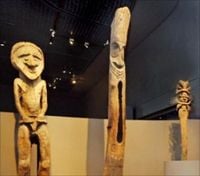The National Museum of Korea in Yongsan-dong, Seoul, is currently hosting a groundbreaking exhibition titled ‘Mana Moana – Art of the Sacred Sea, Oceania,’ which marks the first time Oceanic art and culture are being showcased in South Korea. This exhibition, featuring approximately 170 unique artifacts created by Polynesians, includes canoes, sculptures, stone statues, and musical instruments, all sourced from the Quai Branly-Jacques Chirac Museum in France, renowned for its extensive collection of Oceanic artifacts.
Kim Jae-hong, the director of the National Museum of Korea, emphasized the significance of this exhibition, stating, “This is the first exhibition in Korea to introduce Oceanic culture.” The title ‘Mana Moana’ itself is rich in meaning; ‘Mana’ refers to the spiritual energy that Polynesians believe animates the world, while ‘Moana’ signifies the vast ocean. The exhibition planner, Baek Seung-mi, explained that the title reflects the unseen power and respect for nature that is deeply embedded in Oceanic art and artifacts.
Upon entering the exhibition, visitors are greeted with an immersive experience that simulates a voyage to Oceania, thanks to a captivating video displayed on the walls and floor. This setup invites guests to feel as if they are arriving at a distant island, echoing the adventurous spirit of the Polynesians. The exhibition showcases artifacts related to communal dining and rituals, including masks used during coming-of-age ceremonies, highlighting the cultural significance of these items.
The exhibition is divided into four distinct sections: ‘Territory of Water,’ ‘Territory Where Life Resides,’ ‘Time Forgetting Generations,’ and ‘Islands, People, and People.’ Each section offers a glimpse into the lives of Oceanic peoples, showcasing their navigation and settlement culture, tools and art used in daily life, ancestral worship, and the harmony between community and nature. Notable exhibits include large canoes, intricate sculptures, and ceremonial masks, all of which vividly convey the philosophy and lifestyle of the Oceanic peoples.
Modern art pieces, including paintings and photographs, are also part of the exhibition, providing a contemporary lens through which to view Oceanic culture. Audio guides are available, making the exhibition accessible and enjoyable for families, especially children. The exhibition runs until September 14, 2025, allowing ample time for visitors to explore these rich cultural artifacts.
In conjunction with the exhibition, the article draws parallels to the popular Disney movie ‘Moana,’ which features themes of exploration and connection to the ocean. The film’s protagonist, Moana, is inspired by the Polynesian culture and mythology, and her journey to save her community resonates with the themes present in the artifacts displayed at the museum. The movie includes memorable lines such as, “You can sail beyond the horizon,” echoing the adventurous spirit that Polynesians embody.
As the exhibition unfolds, it also invites visitors to reflect on the broader implications of Oceanic mythology and community values. American mythologist Joseph Campbell noted that myths across cultures share a common structure, often depicting a hero’s journey that restores order within the community. This theme is prevalent in Oceanic culture, where art serves as a vessel for social, political, and spiritual memory.
Throughout the exhibition, the emphasis on connection—both to nature and to one another—resonates strongly. The artifacts are not merely relics of the past; they embody the communal spirit and reverence for nature that define the Oceanic worldview. As visitors observe the intricate designs and the stories behind each piece, they are reminded of the importance of unity and the shared human experience.
The exhibition also serves as a poignant reminder of modern individuals’ struggles with isolation and disconnection. While contemporary society often focuses on material possessions, the Oceanic peoples found meaning in their relationship with the sea and their community. This contrast highlights the depth of connection that can be found in a shared cultural heritage.
As the exhibition encourages visitors to contemplate their own lives, it poses a profound question: What can we learn from the Oceanic way of life? The artifacts on display challenge us to consider the importance of community, respect for nature, and the spiritual connections that bind us all. In a world that often feels fragmented, the exhibition offers a space for reflection and reconnection.
As the exhibition draws to a close in September, it will undoubtedly leave a lasting impact on its visitors, inspiring them to explore the depths of their own connections to the world around them. The ‘Mana Moana’ exhibition is not just a showcase of artifacts; it is an invitation to embark on a journey of discovery, much like Moana herself, as she sails beyond the horizon to find her true calling.
For those interested in experiencing this unique exhibition, it is open from 10 AM to 6 PM on Mondays, Tuesdays, Thursdays, Fridays, and Sundays, and until 9 PM on Wednesdays and Saturdays. Admission is reasonably priced at 5,000 won for adults and 3,000 won for teenagers and children, with free entry for those under six and seniors over 65. Photography is allowed, making it a perfect outing for families and art enthusiasts alike.
As we reflect on the messages conveyed through the artifacts and the stories they tell, one can’t help but wonder: could we, like Moana, embrace the warmth of our connections to nature and each other? Perhaps in doing so, we too can find our own ‘beyond’—a place where we can meet our true selves and the world in all its beauty.




